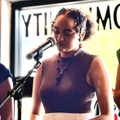Mcristle Ross Minority Painter's Scholarship
Mcristle Ross was a beloved mother who was passionate about art, particularly paintings.
Mcristle’s passion for art was born out of a blended love for creativity, innovation, and people. She enjoyed viewing artistic expressions. As a non-artist, she honed her artistic eye through years of course study and field practice. She marshaled her humble resources to purchase art until she eventually became a budding art collector. She understood the Arts’ role and importance in our life and believed it to be a necessary expression of the human spirit and critical to our existence. She deeply empathized with the plight of artists and sought to support them as much and as often as she could.
This scholarship seeks to honor the memory of Mcristle Ross by supporting minority students who are pursuing artistic degrees in college.
Any African American undergraduate student or high school student accepted to a college or university who is majoring in art or art history may apply for this scholarship. While painters are preferred, all art forms (visual art, sculpture, photography, etc.) are encouraged to apply.
To apply, tell us why you’ve decided to pursue art and what inspires your art. Additionally, submit examples of your work.
Why have you chosen to pursue art? What inspires you artistically? Submit examples of your work.
Winners and Finalists
August 2025
Winning Application












Explore All Kinds of Scholarships for All Kinds of Students
FAQ
The application deadline is Jul 15, 2025. Winners will be announced on Aug 15, 2025.
Your privacy is a top priority on the Bold.org platform, and you can find our privacy policy in full here. You may opt out of communications from Bold.org at any time, and unless we’ve first notified you and gotten your consent, you’ll never receive communication from any third parties related to personal information you give us.
Award amounts per winner are designated by the donor. Check the award amount for a detailed breakdown.
The winner will be publicly announced on Aug 15, 2025. Prior to the announcement date, we may contact finalists with additional questions about their application. We will work with donors to review all applications according to the scholarship criteria. Winners will be chosen based on the merit of their application.
Award checks will be sent to the financial aid office of the winner's academic institution or future academic institution in their name to be applied to their tuition, and in the name of their institution (depending on the school's requirements). If the award is for a qualified educational non-tuition expense, we will work with the winner directly to distribute the award and make sure it goes towards qualified expenses.
Before we award the scholarship, the winner will be required to confirm their academic enrollment status. Depending on the circumstances, verification of Student ID and/or their most recent transcript will be required.
If you have any questions about this scholarship or the Bold.org platform, just email contact@bold.org and we’ll get back to you as quickly as we can.
Yes. The terms and conditions for this scholarship can be found here.


